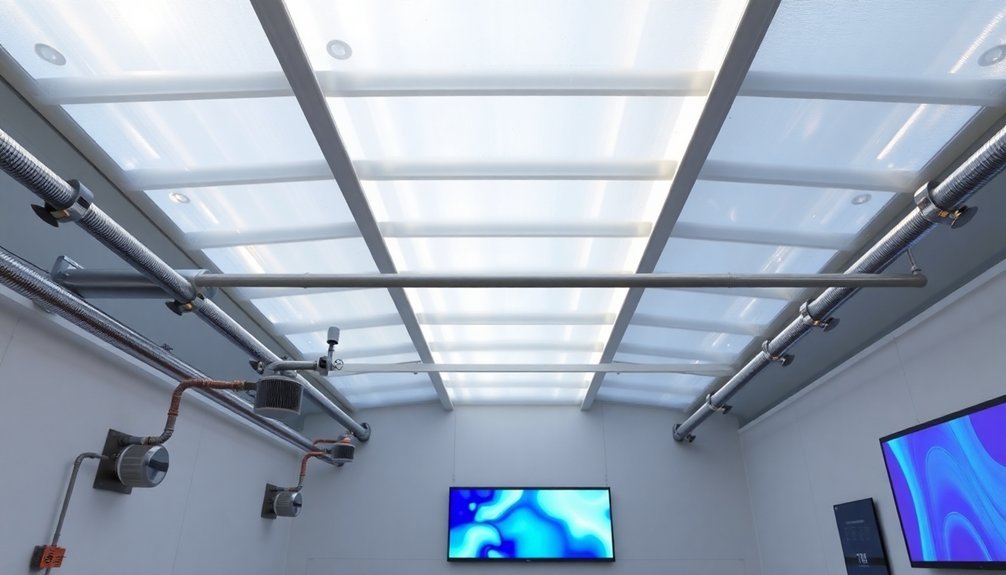Smart ice house airflow control starts with proper cycling management – you'll want to prevent rapid on/off patterns that can disrupt performance. Next, implement pressure-based moisture control by sealing air paths and using desiccant systems with smart controls to maintain ideal humidity levels. Finally, set up multi-zone temperature management with zone valves and pressure-independent balancing valves to achieve specific set points across different areas. When you combine these three design elements with regular maintenance and efficiency optimization techniques, you'll reveal the full potential of your ice house system.
Cold Air Supply Cycling

The ice house's cold air supply faces potential disruptions from short cycling, a common issue that occurs when the system rapidly turns on and off.
You'll need to check several key areas to prevent this problem from affecting your ice house's performance.
Start by examining your thermostat, as it's often the source of cycling issues. Make certain it's not placed near a vent, has fresh batteries, and all wires are securely connected. If your thermostat's sending inconsistent signals, you're likely to experience short cycling.
Airflow problems can trigger short cycling through various mechanisms. You'll want to inspect your air filters monthly and replace them when dirty. Check your A-coil and evaporator coil for blockages, and verify your outdoor unit isn't clogged with debris. Poor airflow can lead to ice formation, creating a cycle of increasingly restricted airflow. A plugged condensate drain can cause the unit to shut down unexpectedly if water backs up.
System imbalances require professional attention. If you're experiencing short cycling, you might've low refrigerant levels, a failing contactor, or an oversized system.
Regular maintenance is essential – schedule professional inspections to check refrigerant levels, clean components, and verify proper system sizing for peak performance.
Pressure-Based Moisture Control
Beyond addressing cold air cycling issues, understanding pressure-based moisture control will help you maintain ideal ice house conditions.
You'll need to recognize that air movement accounts for nearly all water vapor transfer in your facility, with moisture consistently migrating from high to low-pressure areas through any available pathway. The vapor pressure difference drives moisture migration, making proper control essential for ice quality.
To effectively manage moisture levels, you'll want to focus on these critical aspects:
- Seal unintended air paths to minimize unwanted moisture transfer
- Monitor dew point temperatures to prevent condensation on surfaces
- Install proper ventilation systems to maintain optimal humidity levels
Your mechanical system must work in harmony with your dehumidification equipment to prevent fog formation and maintain smooth ice surfaces.
You'll find that desiccant dehumidification systems are particularly effective at keeping the dew point low near the ice surface. Smart control systems can help you monitor and adjust humidity levels automatically, ensuring maximum efficiency.
When you're implementing pressure-based moisture control, remember that it's crucial to balance thermal and moisture loads with your refrigeration system.
Multi-Zone Temperature Management

Implementing multi-zone temperature management in your ice house requires a sophisticated blend of ice-based thermal storage and precise control systems.
You'll need to integrate chillers that cool glycol solution to sub-freezing temperatures during off-peak hours, forming ice around storage coils that you'll later use during peak demand periods. Time-of-use rate savings make this approach particularly cost-effective for facility operators.
You can maintain a steady 44°F supply fluid temperature by mixing antifreeze solution from your ice storage tanks with returning water from active loads.
Your system should include zone valves and pressure-independent balancing valves to manage specific temperature set points in each zone. If you deplete your ice storage during peak periods, you can run chillers at partial capacity to supplement cooling.
To maximize efficiency, you'll want to use hydraulic separators to maintain independent flow rates between your chiller and main loop circulators.
You can optimize your system's performance by adjusting the flow rate of your main loop circulator to match the load circulator. This approach reduces mixing in hydraulic separators and helps you achieve larger delta-T distribution loops of 18°F to 20°F, which means you'll need smaller pipes, ductwork, and components.
Frequently Asked Questions
How Does Ice Build-Up Affect the Performance of Mechanical Flow Rate Controllers?
Your flow controller's performance deteriorates as ice accumulation increases pressure drop, delays response times, and alters hydraulic resistance. You'll notice unstable flow rates and reduced accuracy as the ice continues to build up.
What Backup Systems Are Recommended During Power Failures in Automated Ventilation Systems?
You'll need a battery-powered backup system with fast transfer switches for your ventilation controls. It should include automatic charging, load management features, and enough battery capacity to maintain critical airflow during outages.
Can ERV Systems Be Integrated With Existing Non-Smart Ice House Controls?
Yes, you can integrate ERV systems with your existing non-smart ice house controls. You'll need to connect it to your current ductwork and HVAC system, ensuring proper synchronization with your blower for effective operation.
What Maintenance Schedule Is Optimal for Balanced Ventilation in Sub-Zero Environments?
You'll need to inspect and clean filters monthly, check ERV cores quarterly, and service fans biannually. In sub-zero conditions, you should inspect frost controls weekly and clear any ice buildup immediately.
How Do Variable Volume Systems Adapt to Rapid Temperature Changes Outside?
Your VAV system will rapidly adjust airflow rates while maintaining constant supply air temperature. It'll increase or decrease volume based on sensors detecting outdoor changes, using economizer cycles for ideal temperature control.
In Summary
You'll find these three airflow control designs revolutionize how you manage your ice house environment. By implementing cold air supply cycling, pressure-based moisture control, and multi-zone temperature management, you're able to maintain ideal conditions with minimal energy waste. When you coordinate these systems properly, you'll see improved ice quality and storage longevity while reducing your operational costs and environmental impact.





Leave a Reply